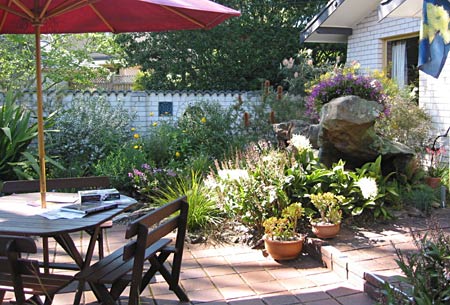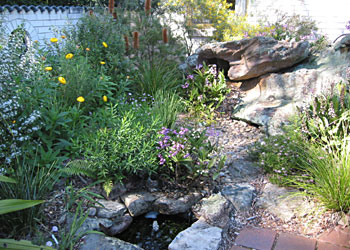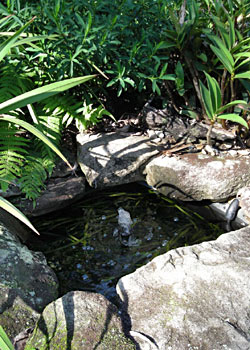
Creating a Small Garden Pond
- a novel approach using a recycled resource
Jeff Howes
I have a north facing front courtyard at my house, in the northern Sydney suburb of Westleigh. In this courtyard I have a large (about 5 tonne) imported sandstone rock that has many native Dendrobiuim kingianum and D.speciosum orchids growing on it, even though it receives full afternoon sun (I should be more correct and call them Thelychiton kingianus and T. speciosus, as they have been recently renamed - Ed. this change is yet to be fully accepted by all authorities).
 |
The courtyard with the sandstone rock at top right
Photo: Jeff Howes |
As I always wanted a small pond/water feature, I created a dry creek bed leading from the rock to a small stainless steel 47 litre laundry tub. To make it all appear 'natural' I undertook the following work:
- Sealed the drain hole and lined the tub with some black butyl rubber sheeting.
- Overlapped the edge of the pond with some bush rock that I had in my garden.
- Placed some 'lucky'- type stones from the rock to the pool, to create a dry creek bed look.
- Added a layer of fine 5 mm gravel to the bottom of the pond and then placed a small pot of a native aquatic plant on the bottom to give the fish somewhere to hide and add some oxygen into the water.
- Installed a small electric pump and timer to run the pump from 9am to 5pm seven days a week. The sound of running water is very pleasant and relaxing and it also helped add oxygen to the water.
- Introduced four or five Pacific Blue-eye native fish to stop any mosquitos breeding. I have had no mosquitos and this is a result of the fish and the splashing water from the pump on the pool surface making life all to difficult for them. The Pacific Blue-eye fish have coped well with the fluctuating summer to winter temperature swings that one must expect in such a small volume of water. I feed the fish every second day or so in summer and only once a week in winter when the water is colder and they slow down. Pacific Blue-eye fish (Pseudomugil signifer) are an Australian native species that occurs in coastal streams along the eastern coast of Australia from northern Queensland to southern New South Wales. They are particularly suited for garden ponds and aquariums as they are a carnivorous fish. They help control mosquitoes by feeding on the larvae and more importantly are frog friendly as they do not generally eat tadpoles. They are about 5-6 cm long and fully grown in 6 months. Do not use the introduced Gambusia affinis, a cold-tolerant strain of mosquito fish as it is a predator that poses a devastating threat to the native frogs and fish in our waterways.
- Added some native snails that breed quite prolifically, to help clean the pond
 |
|
 |
Overall view and closeup view of the pond
Photos: Jeff Howes |
It took only a few weeks for my first Striped Marsh Frog (Limnodynastes peroni) to appear and it even found a mate judging, from all the eggs contained in the foam raft floating on the water surface and resultant tadpoles.
This pool is now five years old and the only problems I had is a build up of some sort of green 'strandy' weed in summer when the pool receives the afternoon sun and the water is warmer. As for maintenance, I change the water every six weeks in summer and a bit longer is winter. When I change the water I add the required amount of chlorine and cholamine remover (available form pet shops) to ensure the fish survival.
Overall a great success for me as it looks great, sounds great, is a watering point for local wildlife and is quite low maintenance.
For more information on building a native fish pond look at "Building Your Native Fish Pond", by the Australia New Guinea Fishes Association.
Australian Plants online - 2008
Association of Societies for Growing Australian Plants
|



